Bangladeshis in Michigan
A Fiber Art Exhibit
Sourced from photos submitted by Bangladeshi Michiganders and my personal collection, these hand-embroidered portraits capture the immigration and settlement journeys of multiple generations of Bangladeshi Americans. The art is contextualized through oral history interviews I conducted and documents the growth and evolution of Michigan’s vibrant Bangladeshi community.
The exhibit was on display from November 30 - December 20, 2023 at the Shaprio Library Gallery in Ann Arbor, MI, as part of the “Arts & Resistance” theme semester at the University of Michigan. Funding for this project was generously provided by the University of Michigan Museum of Art, the U-M Arts Initiative, and the College of Literature, Science, and the Arts.
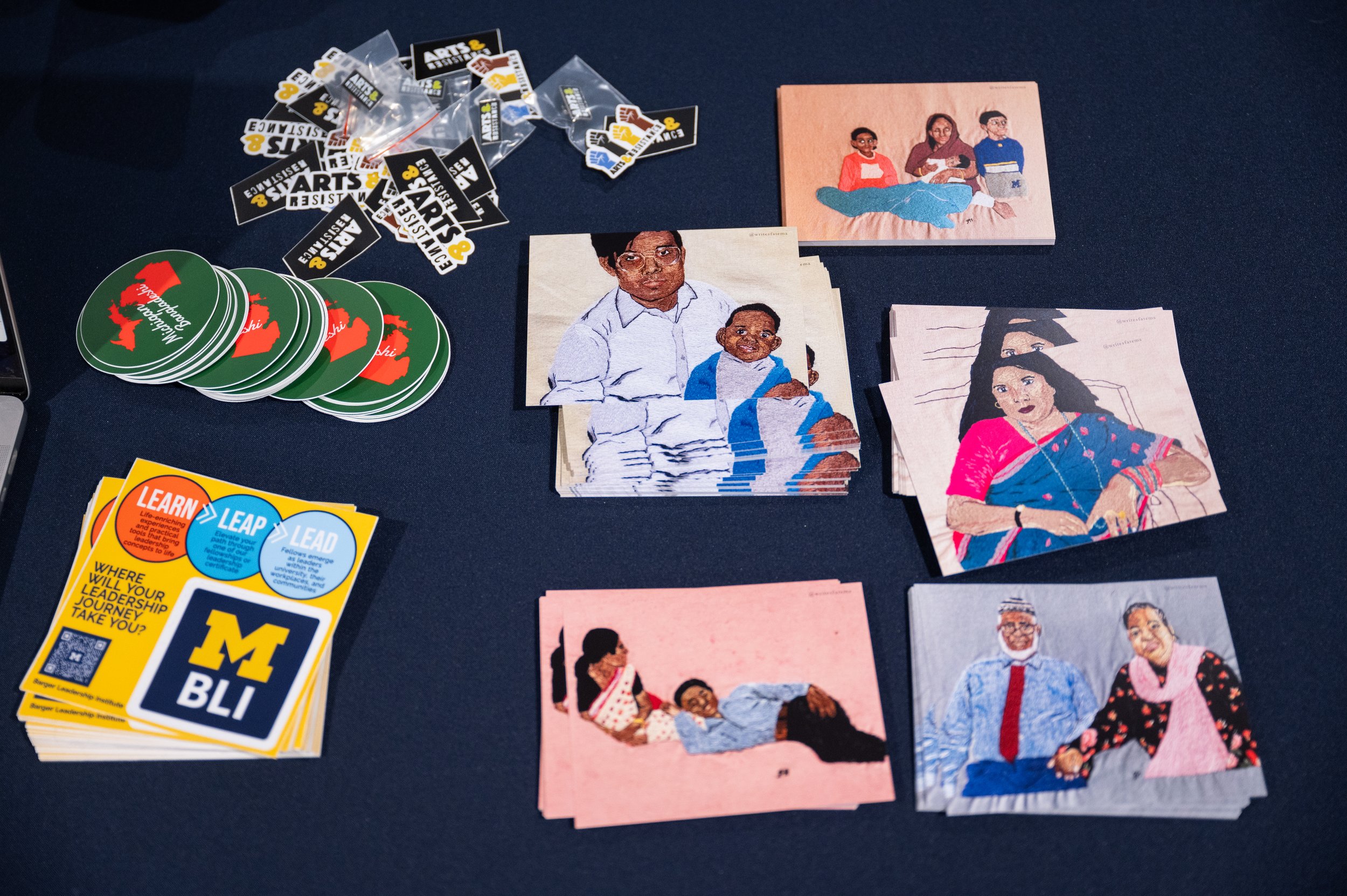

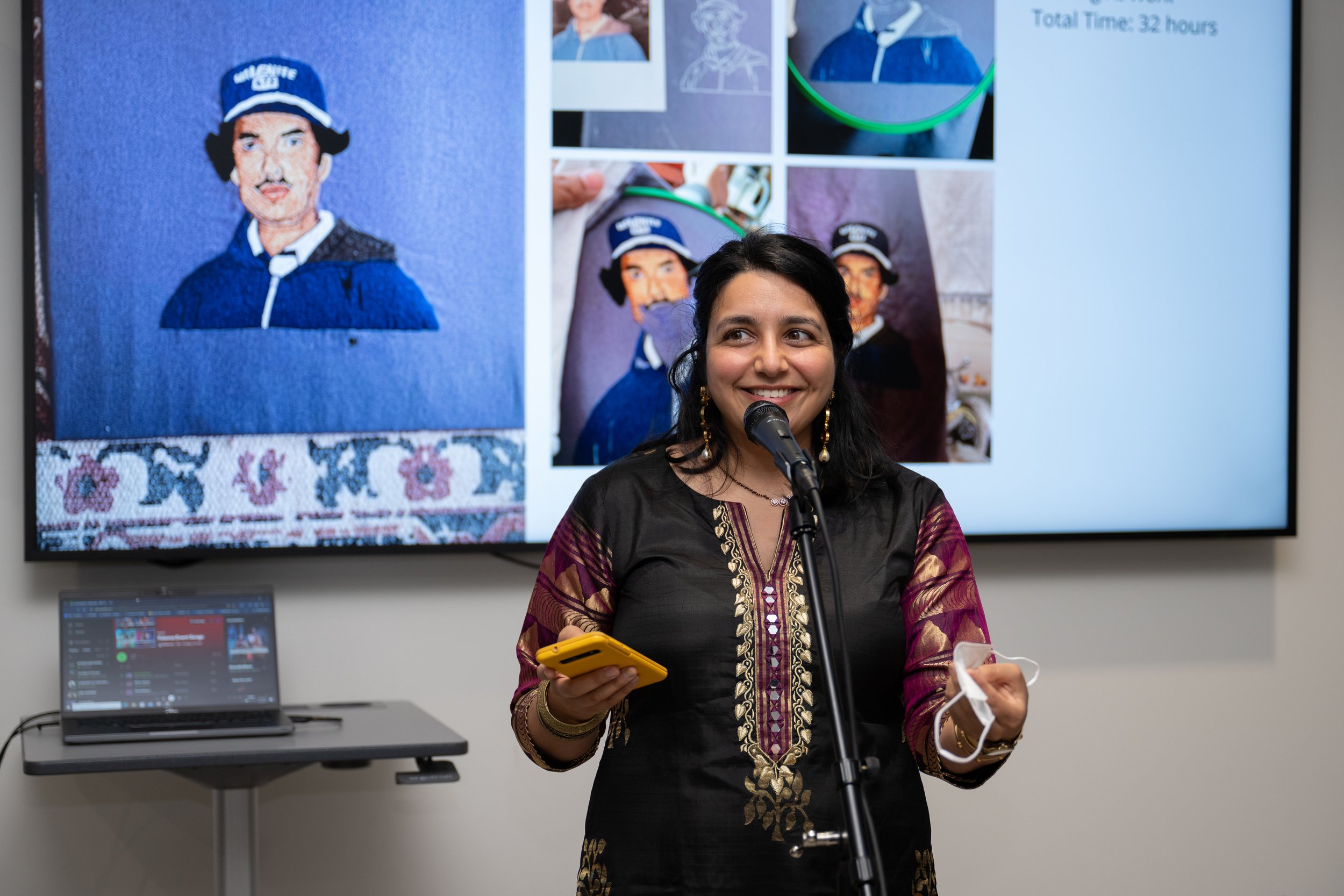
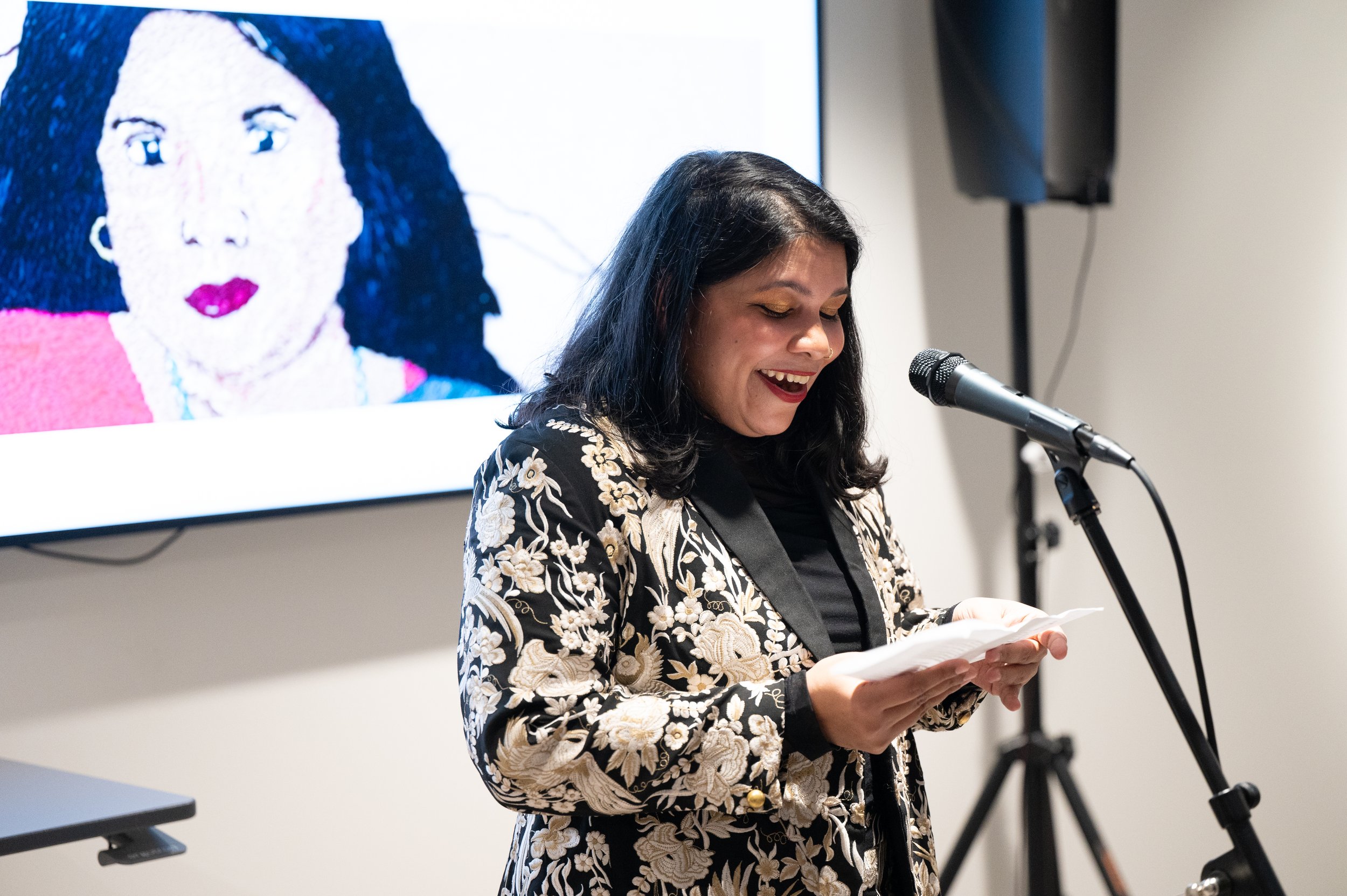
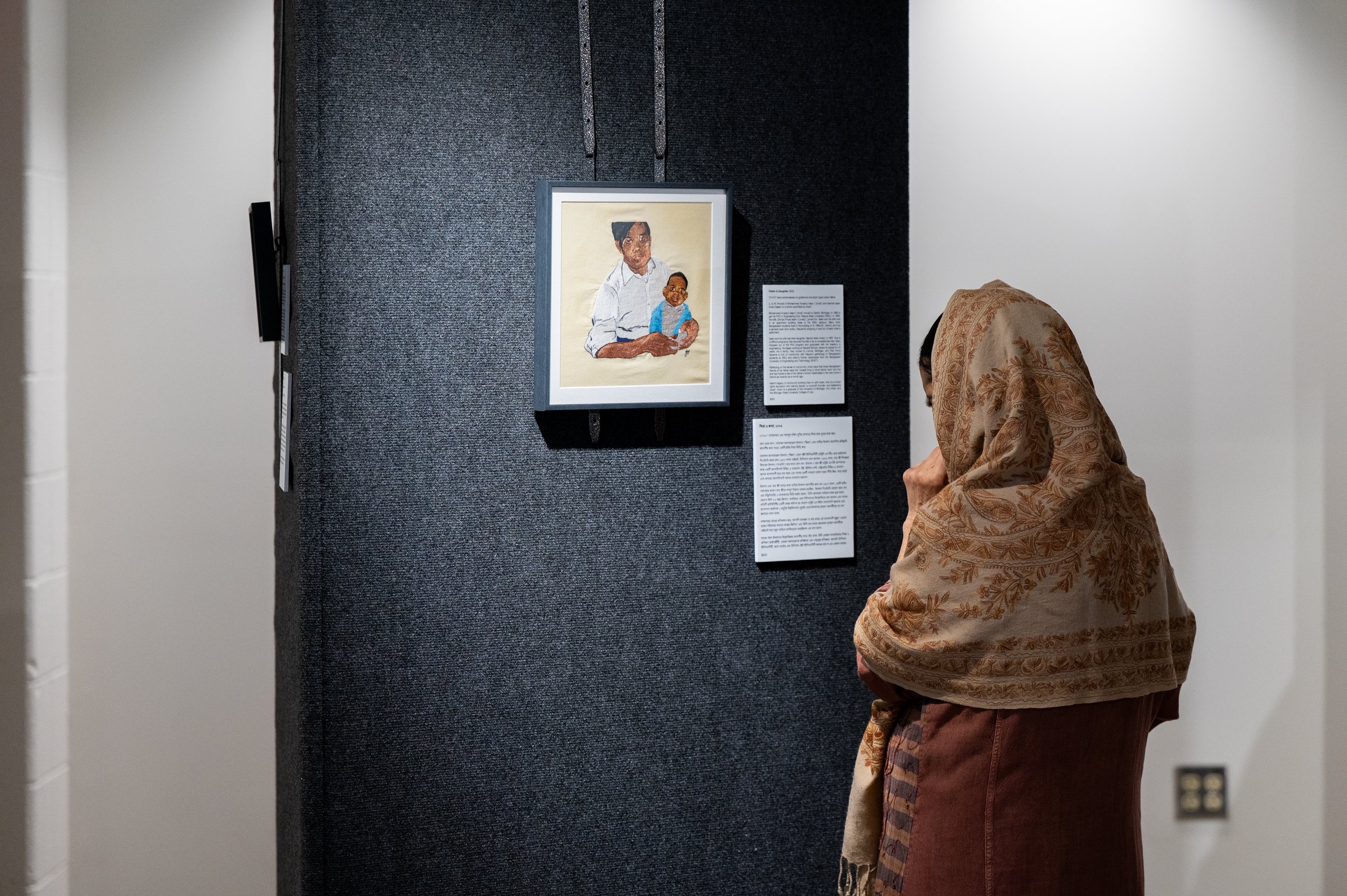
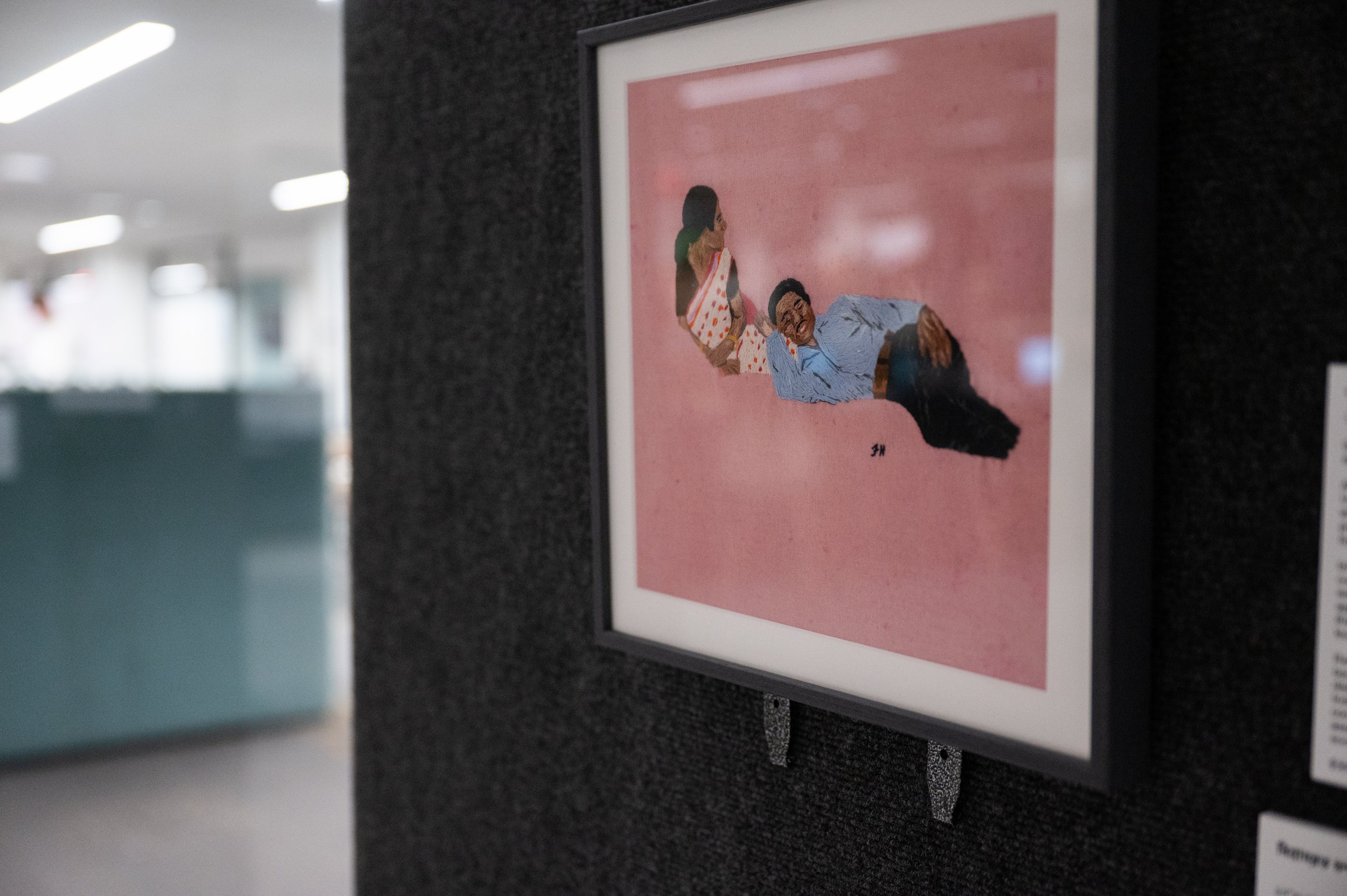
In the Media
Fatema Haque explores Bangladeshi community through portrait project, WDET - Detroit’s NPR Station, 12 January 2024.
‘Bangladeshis in Michigan’ exhibit highlights growth of the community, WDET - Detroit’s NPR Station, 11 December 2023.
Fatema Haque’s Hand Embroidery Captures Immigration History, Bangla Shangbad, 2 December 2023.
The Unanticipated Gifts of Making Art, Bengalis of New York, November 2023.
The Exhibit
Elderly Couple, 2023
9”x12” hand-embroidered on cotton fabric
(L to R) Portrait of Syed Manik Miah and Shaheda Dolly Miah-Haque based on a photo submitted by Nazneen Miah.
Syed Manik Miah’s grandfather came to America by ship in 1912. When the ship docked in New York, he only meant to sightsee, but as fate would have it, he got lost and couldn’t find his way back to the ship. He stayed in New York and eventually moved to Michigan.
Miah immigrated to Detroit, Michigan, in 1972 from Dakshin Surma, Sylhet, Bangladesh. His older brother, who had moved to America in 1965, sponsored his visa. Recalling life in Detroit in the 1970s, Miah says that there were only 15 or so Bangladeshis, with ten elders and five younger people like himself. His first job was as a dishwasher for Big Boy Restaurant where he earned $2.65 per hour. In those first few years, there were no mosques to worship in, no butcher shops to purchase halal meat, no grocery stores that sold South Asian spices. He recalls cooking curry with spaghetti sauce and eventually shopping from Arab stores in Eastern Market whenever he could get out there.
Miah met his wife, Shaheda Dolly Miah-Haque, at her father’s restaurant, Taj Mahal Restaurant, in Berkley, Michigan, when Miah went to apply for a job there. The two married quickly and went on to have three children, two girls and a boy. Miah-Haque was the first Sylheti woman in Michigan to get her driver’s license. She loved her freedom and drove their family around in their Chevrolet Monte Carlo. She passed away in April 2022.
Reflecting on how metro Detroit has changed over time, Miah says that the cities have gone from being an unfamiliar territory to a second Bangladesh. “Warren is like Bangladesh, and Hamtramck feels like Sylhet. I don’t think about Bangladesh much anymore.”
Couple in Repose, 2023
10”x10” hand-embroidered on cochineal and alum dyed cotton fabric
(L to R) Portrait of Rubaiya Khan and Abdul Majid Khan based on a photo submitted by Adil Khan.
Abdul Majid Khan moved to Ann Arbor, Michigan, in 1976 to enroll in the University of Michigan’s graduate program in Nuclear Engineering. His wife, Rubaiya Khan, and their two children joined him in 1978. In this portrait, the couple can be seen relaxing near their graduate student housing on Murfin Ave.
Initially, the Khans intended to return to Bangladesh once Abdul Khan completed his graduate education. However, circumstances led them to settle here, eventually sponsoring their siblings and parents so that approximately 39 members of their family relocated to Michigan. Three of these family members have passed away in recent years and are buried locally.
Recalling back to the earlier days of their immigration, the Khans say that because the Bangladeshi community was so small, there was much less distinction between groups. Muslims, Hindus, Bengalis, Pakistanis, and Indians all spent time together and did not self-segregate. Today, communities are much more insular in the sense that people generally associate within their family circles or self-segregate based on socioeconomic, religious, or regional (e.g., Sylhet, Dhaka, etc.) ties.
Thriving at Work, 2023
10”x10” hand-embroidered on cotton fabric
Portrait of Sofrul H. Lasker based on a photo submitted by Iffat Lasker.
Sofrul H. Lasker immigrated with his wife and two children to Michigan in the late 1970s. In the 1980s, he began working for Valenite, LLC, a manufacturing company in Madison Heights, Michigan. At the time, Valenite was one of the biggest suppliers of motor vehicle components in the United States, serving both General Motors and Ford. Lasker took pride in the company he worked for, primarily because they seemed “ahead of their time.” While other factories provided free non-halal turkeys to their employees during Thanksgiving, Valenite went “above and beyond” to accommodate the Muslim workers with prayer breaks year-round and iftar breaks during Ramadan. Valenite also held an annual festival for its employees and their families, with rides, food, face painting, music, and cotton candy. Lasker attended this festival each year with his family, and all the Bangladeshis who worked for Valenite would treat it as an occasion to gather in community.
Father & Daughter, 2023
10”x10” hand-embroidered on goldenrod and alum dyed cotton fabric
(L to R) Portrait of Mohammed Anwarul Islam (“Jinna”) and Namira Islam Anani based on a photo submitted by Anani.
Mohammed Anwarul Islam (“Jinna”) moved to Detroit, Michigan, in 1985 to get his PhD in Engineering from Wayne State University (WSU). In 1986, his wife, Dilruba Firoza Islam (“Lovely”), joined him. Islam and his wife lived in an apartment building close to the WSU campus. Many other Bangladeshi students lived in the building on E. Willis St., Detroit, and had a general open-door policy, frequently dropping in and out of each other’s apartment.
Islam and his wife had their daughter, Namira Islam Anani, in 1987. Due to a difficult pregnancy that required his wife to be on complete bed rest, Islam dropped out of the PhD program and graduated with his master’s in engineering. He began working at General Motors, where he stayed for 33 years. As a family, they moved to Livonia, Michigan, and their home became a hub of community with frequent gatherings of Bangladeshi students at WSU and Islam’s former classmates from the Bangladesh University of Engineering and Technology (BUET).
Reflecting on the sense of community, Anani says that these Bangladeshi friends of her father were the “closest thing to blood family here” and that she had hosted a few of her father’s former classmates in her new home in Detroit as recently as a month ago.
Islam’s legacy of community building lives on with Anani, who is a human rights education and training lawyer, a nonprofit founder, and leadership coach. Anani is a graduate of the University of Michigan, Ann Arbor, and the Michigan State University College of Law.
Abba, 1989, 2022
5”x5” hand-embroidered on cotton fabric
Portrait of Mohammed Azizul Haque, father of artist.
Beginning in 1990, Michigan saw a second wave of Bangladeshi immigrants with upwards of 15,000 Bangladeshis moving into the state. Most of these new immigrants were men traveling alone for work. Mohammed Azizul Haque is one such immigrant: he moved to Detroit, Michigan, from Sylhet, Bangladesh, in 1991.
Haque lived in a shared residence with other new immigrants in a communal living arrangement that benefited all. These hostel-style residences were common in the 1990s. Men who lived together became each other’s family, taking turns cooking meals, doing household chores such as cleaning and grocery shopping, and carpooling to work, as only one or two residents owned a vehicle. They meticulously tracked expenses and split them equally, typically at the end of each month.
Co-operative households became less common as families reunited in the early 2000s. Today, they are practically nonexistent in Detroit and Hamtramck.
Kakamoni, 2023
8”x10” hand-embroidered on avocado and alum dyed cotton fabric
Portrait of Mst Kolsuma Begum Ruji, aunt of artist.
Bangladeshi women in Michigan have been vital to the growth and success of their communities. They maintained homes, raised families, and cultivated community. Many Bangladeshis who grew up in Michigan in the 1990s and 2000s recall their mothers hosting or attending dawats, social gatherings, in each other’s homes, cooking elaborate meals and talking late into the night.
Some women served as connectors between Bangladesh and America, transporting and selling clothing such as salwar kamizes, and food such as shutki (dried fish) and dried shatkora (wild orange) before they were readily available in stores. They also delivered letters and care packages from loved ones.
While most early immigrant women were homemakers, nurturing children, taking care of the elderly, and managing households, a good number worked informally, running carpool services for neighborhood children, and helping them commute safely to schools. Others worked in vegetable packing factories or at schools. Today, Bangladeshi women work in nearly all sectors, from health to education to business, and serve as indispensable cultural educators for future generations.
Baby’s First Day at Home, 2023
9”x12” hand-embroidered on avocado, goldenrod, and alum dyed cotton fabric
(L to R) Portrait of Fatematuz Zohara Chamak, Rahima Mossomat Khatun, Rafiul Mohammed Ashraf, and Mohammed Ashraf Opu based on a photo submitted by Chamak.
Fatematuz Zohara Chamak’s family immigrated to America in 1996. Her father worked as a taxi driver in Astoria, Queens, New York, and they lived with a relative. However, supporting a family in New York on a taxi driver’s salary was challenging, so Chamak’s father sent Chamak, her brother, Mohammed Ashraf Opu, and her mother, Rahima Mossomat Khatun, back to Bangladesh.
The family reunited in 2000 when Chamak’s father moved them to Hamtramck, Michigan, where the cost of living was lower and there was more space for a growing family. Chamak’s brother Rafiul Mohammed Ashraf was born on January 20, 2000. Khatun and newborn Ashraf came home to their rented attic apartment in Hamtramck on February 6, 2000.
Recalling what her childhood was like as a new immigrant, Chamak says that she remembers her world being limited to the boundaries of her home, the street she lived on, her school, and the mosque. Her mother rarely left the home and her father worked long hours at Technicolor Videocassette, so Chamak and Opu were frequently unchaperoned.
The Bangladeshi community in Hamtramck seems larger and more vibrant now, Chamak says. Even though everyone she grew up with has moved away from Hamtramck, many new Bangladeshi immigrants have made the area their home and many Bangladeshi women and children can be seen out and about.
Nanu, 2022
8”x10” hand-embroidered on beet and alum dyed cotton fabric
Portrait of Toizun Nessa, grandmother of artist.
Grandparents play a special role in the lives of their grandchildren. For many Bangladeshi children who grew up with a grandparent in their household, the grandparent was their first roommate. They spent quality time with children, telling them stories, putting coconut oil in their hair, and painting their hands with mehndi (henna). They also served as spiritual educators, teaching children duas and suras from the Quran. If both parents worked outside the home, grandparents provided childcare, and for children separated from their parent(s) due to immigration delays, grandparents served as parents.
Afsana, 2022
10”x10” hand-embroidered on cotton fabric
Portrait of Afsana Haque, niece of artist.
Afsana Haque immigrated to Detroit, Michigan, from Zakiganj, Sylhet, Bangladesh, in 2020 at the age of three. She is a bright, curious, energetic girl who enjoys reading, dancing, and playing Minecraft with her brothers. She is fluent in English and Bengali, and she is learning Arabic.
Children like Afsana are central to Bangladeshi Michiganders’ political participation. Teenagers and adults alike have been organizing over the last decade to campaign for halal food in school cafeterias, recognizing Eid as an official holiday for schools with higher concentration of Muslim students, and improving pedestrian safety with crosswalks. Mothers have also become active participants, with some joining school boards and organizing meetings with other parents to combat bullying, Islamophobia, and access to academic resources. These types of civic engagement signal a greater sense of belonging in the state for Bangladeshi immigrants and their families.
Armaan, 2022
8”x10” hand-embroidered on cotton fabric
Portrait of Armaan Haque, nephew of artist.
Armaan Haque was born in Michigan. He is highly observant and clever. He enjoys video games, Takis, and Five Nights at Freddy’s. He will try new foods at least once, usually to appease his aunt. When he was younger, his favorite food was chicken curry; these days, he enjoys a good burger. He is great at math.
Second generation children experience a very different childhood than their first gen/immigrant parents and grandparents. They tend to have a more diverse group of friends, often outside of ethnic, racial, or religious groups. They also have a higher standard of living with access to more resources than their parents had. Their responsibilities differ from their immigrant/first gen parents. For instance, they do not have to serve as translators for their parents or help their parents navigate various systems.
Amir, 2023
10”x10” hand-embroidered on cotton fabric
Portrait of Amir Haque, nephew of artist.
Amir Haque was born in Michigan. He is kind, loyal, and just. Quick to come to other’s defense, he isn’t afraid to call out unfairness when he sees it. He enjoys sports, Minecraft and Roblox, and dancing. He’s a sweet older brother to his sister, helping her learn new things and spending time with her.
Always willing to lend a hand, Amir helps his aunt set up the family garden every spring. Bangladeshi Michiganders love gardening. Lush vegetable gardens can be found in nearly every Bangladeshi home in Detroit and Hamtramck: shim (bean) and lau (bottle gourd) vines reaching over backyard fences; green chilis rising tall; eggplant and tomato plants heavy with fruit. These gardens are also a source of connection: Bangladeshis visit each other’s gardens, admiring plants and sharing in the abundance. If an unexpected frost kills a plant, a neighbor is sure to have extras to share. In many ways, these gardens are a little piece of the home they left behind.










